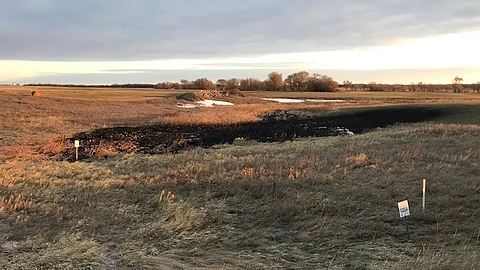

Is it the final nail in the coffin, or the spark that reignites a stalled pipeline project?
That’s because a rupture in the original Keystone oil pipeline on the US side of the border early Tuesday morning has once again thrust the controversial project into the bi-lateral spotlight, raising fresh questions about the future — or finality — of the once-ambitious Keystone XL expansion.
The spill, which occurred near Fort Ransom, North Dakota, forced a shutdown of the pipeline that channels Canadian crude to US refineries.
While the crude was reportedly contained to a remote field with no injuries or other damage, the incident is already rippling beyond the farmland, reigniting debate over whether Keystone XL is a project worth reviving or finally retiring for good.
“This might be the beginning of the end for any dreams of resurrecting Keystone XL,” said one energy analyst, “or, paradoxically, the event that pushes industry and politicians to argue it’s time to ‘do it right’ with new infrastructure.”
According to South Bow — the Calgary-based operator now managing the pipeline, which was originally developed by TC Energy — the rupture was detected after a sudden drop in pressure triggered automatic leak detection systems.
A field worker reportedly heard a “mechanical bang” and shut down the system within two minutes. Oil was later seen bubbling up roughly 300 metres from the nearest pump station.
“The affected segment has been isolated, and operations and containment resources have been mobilized,” the company said in a statement, adding that its top priority is “the safety of onsite personnel and mitigating the risk to the environment.”
Officials with the North Dakota Department of Environmental Quality downplayed the scale of the incident, calling it a “fairly good volume” but “not that huge” in comparison to previous spills, including a 2019 event in Walsh County.
Tuesday’s leak comes just weeks after US president Donald Trump pledged to revive the long-dead Keystone XL project, calling it “the pipeline that should’ve never been cancelled.”
Deep-sixed in 2021 by the Biden administration following years of environmental opposition and legal delays, Keystone XL was meant to be the high-capacity southern leg of the Keystone system, moving crude all the way to Gulf Coast refineries.
If built, it would have provided a bullet line for 1 million barrels per day (bpd) of diluted bitumen to the largest complex of heavy oil refineries in the world.
In February, Trump urged original developers or a new operator to resume construction, promising “fast-track approvals” under a future Republican administration. But South Bow, which assumed control of TC Energy’s liquid pipeline assets in 2024, has signalled it has little interest in unearthing the KXL corpse.
“We’ve moved on,” spokesperson Katie Stavinoha said last month. “We continue to engage with customers to develop other options to increase Canadian oil supplies to meet growing demand.”
For critics, Tuesday’s rupture is a grim reminder of the risks tied to aging fossil fuel infrastructure. But for its backers, the incident may offer an excuse to call for a reboot of the original plan, not a retirement.
“Incidents like this just prove we need newer, safer, more modern pipelines,” said one pro-industry source. “Keystone XL would’ve used the latest tech. Now we’re stuck with legacy lines that keep failing.”
Whether Tuesday’s rupture ends the KXL saga for good or sets the stage for its resurrection remains to be seen. But for now, the controversial conduit is once again making headlines — just not the way anyone wanted.
